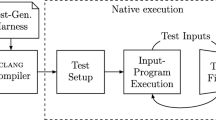Abstract
Anti-random testing has proved useful in a series of empirical evaluations. The basic premise of anti-random testing is to chose new test vectors that are as far away from existing test inputs as possible. The distance measure is either Hamming distance or Cartesian distance. Unfortunately, this method essentially requires enumeration of the input space and computation of each input vector when used on an arbitrary set of existing test data. This prevents scale-up to large test sets and/or long input vectors.
We present and empirically evaluate a technique to generate anti-random vectors that is computationally feasible for large input vectors and long sequences of tests. We also show how this fast anti-random test generation (FAR) can consider retained state (i.e. effects of subsequent inputs on each other). We evaluate effectiveness of applying anti-random vectors for behavioral model verification using branch coverage as the testing criterion.
Similar content being viewed by others
References
T.J. Bai, T. Cottrell, D.-Y. Hao, T. Te, and R.J. Brozka, “Multi-Dimensional Sphere Model and Instantaneous Vegetation Trend Analysis,” Ecological Modeling, vol. 97, no. 1/2, pp. 75–86.
F. Fallah, S. Devadas, and K. Keutzer, “OCCOM: Efficient Computation of Observability-based Metrics for Functional Verification,” in Proc. 35th Design Automation Conference, 1998, pp. 152–157.
R. Hamlet and R. Taylor, “Partition Testing does not Inspire Confidence,” IEEE Transactions on Software Engineering SE-16, vol. 12, pp. 1402–1411, December 1990.
W. Howden, “Systems Testing and Statistical Test Data Coverage,” in Proc. COMPSAC '97, Washington, DC, 1997, pp. 500–504.
R. Kapur, S. Patil, T. Snethen, and T.W. Williams, “A Weighted Random Pattern Test Generation System,” IEEE Transactions on Computer-Aided Design of Integrated Circuits and Systems, vol. 15, no. 8, pp. 1020–1025, August 1996.
S.J. Leon, Linear Algebra with Applications, 4th ed.,New Jersey: Prentice Hall, Inc., 1994.
Y.K. Malaiya, “Anti-random Testing: Getting the Most out of Black-Box Testing,” in Proc. ISSRE'95, Toulouse, 1995, pp. 86–95.
P.A. Thaker, V.D. Agrawal, and M.E. Zaghloul, “ValidationVector Grade (VVG): A New Coverage Metric for Validation and Test,” in Proc. 17th IEEE VLSI Test Symp., 1999, pp. 182–188.
M.Z. Tsoulakos, J.W. Duran, and S.-C. Ntafos, “On Some Reliability Estimation Problems in Random and Partition Testing,” IEEE Transactions on Software Engineering SE-19, vol. 7, pp. 687–697, July 1993.
A. von Mayrhauser, T. Chen, et al., “On Choosing Test Criteria for Behavioral Level Hardware Design Verification,” in Proc. HLDVT'2000, Bekerley, CA, November 2000.
H. Yin, Z. Lebnedengel, and Y.K. Malaiya, “AutomaticTest Generation using Checkpoint Encoding and Anti-random Testing,” in Proc. ISSRE'97, Albuquerque, NM, 1997, pp. 84–95.
Author information
Authors and Affiliations
Rights and permissions
About this article
Cite this article
Chen, T., Bai, A., Hajjar, A. et al. Fast Anti-Random (FAR) Test Generation to Improve the Quality of Behavioral Model Verification. Journal of Electronic Testing 18, 583–594 (2002). https://doi.org/10.1023/A:1020844805564
Issue Date:
DOI: https://doi.org/10.1023/A:1020844805564




